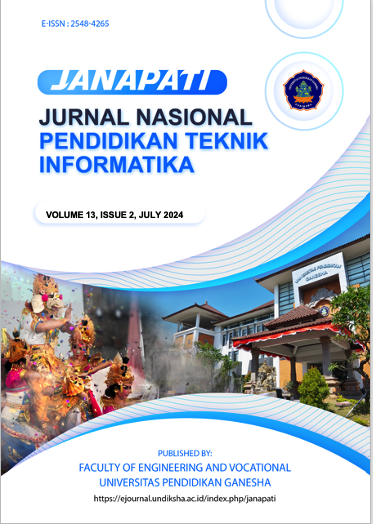Innovative Learning Model for Dharmagita Based on Telegram Chatbot
DOI:
https://doi.org/10.23887/janapati.v13i2.78535Keywords:
Chatbot, Rasa Framework, Natural Language Understanding, DharmagitaAbstract
In the digital era, instant messaging has become a vital aspect of people's daily lives, especially among the younger generation. This presents opportunities to utilize technology that can be integrated into instant messaging as a learning medium. This research innovates to develop a learning model for Dharmagita, also known as sacred Hindu songs, using a chatbot as a platform aimed at attracting the interest of the younger generation in studying Dharmagita as a cultural heritage. This chatbot was developed using the Rasa framework, which is founded on Natural Language Understanding (NLU). Based on the results of the User Acceptance Test, the Dharmagita Chatbot received a positive response from users. The chatbot model achieved an accuracy value of 86.7%, an F1-score of 88.4%, and a precision of 91.1%. These results underscore the effectiveness and reliability of the chatbot in facilitating learning and engagement with Dharmagita content.
References
G. S. Mahendra and A. I. K. Asmarajaya, "Konservasi Kidung Sekar Madya dalam Aplikasi Berbasis," Jurnal Sistem dan Teknologi Informasi, vol. 10, no. 4, pp. 542-549, 2022. doi: 10.26418/justin.v10i4.56806
N. P. Gatriyani and I. W. Jatiyasa, "Pembinaan Keterampilan Dharmagita Pada Sekaa Teruna Teruni Di Banjar Dinas Pura Desa Sebudi Kecamatan Selat Kabupaten Karangasem," Dharma Jnana, vol. 2, no. 2, pp. 73-84, 2022.
I. W. Artayasa, "Strategi Sekolah Dalam Menanamkan Pendidikan Agama, Bangsa, dan Sastra," Kalangwan Jurnal Pendidikan Agama dan Bahasa, Sastra, vol. 10, no. 1, pp. 71-79, 2020.
A. W. Finaka, "Infografis," 2018. [Online]. Available: https://indonesiabaik.id/infografis/663-masyarakat-indonesia-memiliki-smartphone-8.
Sakiyem, "Dampak Positif dan Negatif Penggunaan Gadged Bagi Pengunanya," Kanwil Kemenag Prov. Kep. Bangka Belitung, 10 July 2019. [Online]. Available: https://babel.kemenag.go.id/id/id/opini/591/Dampak-Positif-dan-Negatif-Penggunaan-Gadget-Bagi-Penggunanya.
E. L. Amalia and D. W. Wibowo, "Rancang Bangun Chatbot Untuk Meningkatkan Performa Bisnis," Jurnal Ilmiah Teknologi Informasi Asia, vol. 13, no. 2, pp. 137-142, 2019. doi: 10.32815/jitika.v13i2.410
O. Sudana, K. V. M. Sukma, A. Wirdiani and G. A. A. Putri, "E-Dharmagita Learning Model Innovation with Mobile and Multimedia Technology," Scientific Journal of Informatics, vol. 11, no. 1, pp. 41-52, 2024. doi: 10.15294/sji.v11i1.46653
I. K. O. N. Kaskora, I. M. Sukarsa and N. M. I. Marini, "Design of Daily Hindu Prayer Applications Based on Telegram Bot," Jurnal Ilmiah Merpati, vol. 9, no. 2, pp. 108-188, 2021. doi: 10.24843/JIM.2021.v09.i02.p02
M. I. Ardimansyah and M. H. Widianto, "Development of Online Learning Media Based on Telegram Chatbot (Case Studi : Programming Courses)," Journal of Physics: Conference Series, pp. 1-6, 2020. doi: 10.1088/1742-6596/1987/1/012006
S. Pradana, "Utilizing Telegram And Whatsapp As Effective Substitute Media For Teaching English," Journal on Education, vol. 04, no. 04, pp. 1867-1873, 2022.
D. Handayani and M. Salam, "Aplikasi Sistem Informasi Simpan Pinjam Koperasi Berbasis Website Menggunakan Metode Waterfall," KLIK: Kajian Ilmiah Informatika dan Komputer, vol. 3, no. 5, pp. 425-434, 2023. doi: 10.30865/klik.v3i5.676
D. Abimanto and I. Mahendro, "Penggunaan Aplikasi Telegram Untuk Kegiatan Pembelajaran Jarak Jauh Pada Mata Kuliah Bahasa Inggris Materi Speaking Pada Mahasiswa Universitas Maritim Amni Semarang," Prosiding Kemaritiman 2021, pp. 245-256, 2021.
D. Chai, U. Gajah, E. M. Simarmata and Y. Laia, "Aplikasi Penyimpanan File Alternatif Bagi Pengguna Smartphone Berbasis Android," Jurnal Sistem Informasi dan Ilmu Komputer Prima (JUSIKOM Prima), vol. 3, no. 1, pp. 35-42, 2019. doi: 10.34012/jusikom.v3i1.555
M. N. Arifin and D. Siahaan, "Structural and Semantic Similarity Measurement of UML Use Case Diagram," Lontar Komputer : Jurnal Ilmiah Teknologi Informasi, vol. 11, no. 2, pp. 88-100, 2020.
D. G. S. Ruindungan and A. Jacobus, "Chatbot Development for an Interactive Academic Information Services using the Rasa Open Source Framework," Jurnal Teknik Elektro dan Komputer, vol. 10, no. 1, pp. 61-68, 2021.
M. R. Sholahuddin and F. Atiqya, "Sistem Tanya Jawab Konsultasi Shalat Berbasis RASA Natural Language Understanding (NLU)," Jurnal Pendidikan Multimedia, vol. 3, no. 2, pp. 93-102, 2021. doi: 10.17509/edsence.v3i2.38732
L. Anindyati, "Analisis dan Perancangan Aplikasi Chatbot Menggunakan Framework Rasa dan Sistem Informasi Pemeliharaan Aplikasi (Studi Kasus: Chatbot Penerimaan Mahasiswa Baru Politeknik Astra)," Jurnal Teknologi Informasi dan Ilmu Komputer (JTIIK), vol. 10, no. 2, pp. 291-300, 2022. doi: 10.25126/jtiik.20231026409
G. CI, "Rasa Glossary," Rasa Technologies GmbH, 21 March 2024. [Online]. Available: https://rasa.com/docs/.
A. Jiao, "An Intelligent Chatbot System Based on Entity Extraction," Journal of Physics: Conference Series, 2020. doi: 10.1088/1742-6596/1487/1/012014
G. CI, "Actions," Rasa Technologies GmbH, 21 March 2024. [Online]. Available: https://rasa.com/docs/rasa/actions/.
W. Hadikurniawati, S. Wijono, D. Manongga and I. Sembiring, "Toddler Stunting Consulting Chatbot using Rasa," Jurnal Rekayasa Elektrika, vol. 19, no. 4, pp. 160-166, 2023. doi: 10.17529/jre.v19i4.33014
A. R. Yusmita, H. Anra and H. Novriando, "Sistem Informasi Pelatihan pada Kantor Unit Pelaksanaan Teknis Latihan Kerja Industri (UPT LKI) Provinsi Kalimantan Barat," Jurnal Sistem dan Teknologi Informasi, vol. 8, no. 2, pp. 160-169, 2020. doi: 10.26418/justin.v8i2.36797
Downloads
Published
How to Cite
Issue
Section
License
Copyright (c) 2024 Ni Putu Utari Dyani Laksmi, A.A. Kompiang Oka Sudana, AA.Kt.Agung Cahyawan Wiranatha

This work is licensed under a Creative Commons Attribution-ShareAlike 4.0 International License.
Authors who publish with Janapati agree to the following terms:- Authors retain copyright and grant the journal the right of first publication with the work simultaneously licensed under a Creative Commons Attribution License (CC BY-SA 4.0) that allows others to share the work with an acknowledgment of the work's authorship and initial publication in this journal
- Authors are able to enter into separate, additional contractual arrangements for the non-exclusive distribution of the journal's published version of the work (e.g., post it to an institutional repository or publish it in a book), with an acknowledgment of its initial publication in this journal.
- Authors are permitted and encouraged to post their work online (e.g., in institutional repositories or on their website) prior to and during the submission process, as it can lead to productive exchanges, as well as earlier and greater citation of published work. (See The Effect of Open Access)







